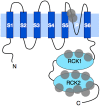Emerging role of the KCNT1 Slack channel in intellectual disability
- PMID: 25120433
- PMCID: PMC4112808
- DOI: 10.3389/fncel.2014.00209
Emerging role of the KCNT1 Slack channel in intellectual disability
Abstract
The sodium-activated potassium KNa channels Slack and Slick are encoded by KCNT1 and KCNT2, respectively. These channels are found in neurons throughout the brain, and are responsible for a delayed outward current termed I KNa. These currents integrate into shaping neuronal excitability, as well as adaptation in response to maintained stimulation. Abnormal Slack channel activity may play a role in Fragile X syndrome, the most common cause for intellectual disability and inherited autism. Slack channels interact directly with the fragile X mental retardation protein (FMRP) and I KNa is reduced in animal models of Fragile X syndrome that lack FMRP. Human Slack mutations that alter channel activity can also lead to intellectual disability, as has been found for several childhood epileptic disorders. Ongoing research is elucidating the relationship between mutant Slack channel activity, development of early onset epilepsies and intellectual impairment. This review describes the emerging role of Slack channels in intellectual disability, coupled with an overview of the physiological role of neuronal I KNa currents.
Keywords: Fragile X syndrome; KCNT1; Slack; epilepsy; intellectual disability.
Figures


References
Publication types
Grants and funding
LinkOut - more resources
Full Text Sources
Other Literature Sources
Molecular Biology Databases

